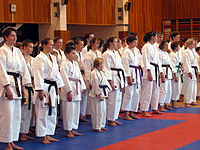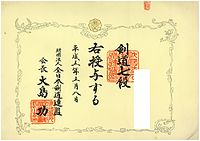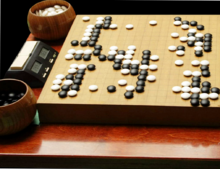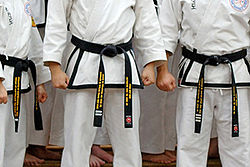- Dan (rank)
-
Dan (rank) 
Dan and Kyū ranks are indicated by belt color or by stripes on the belt Japanese name Kanji: 段 Hiragana: だん Transliterations - Revised Hepburn: Dan The dan (段 dan) ranking system is a Japanese mark of level, which is used in modern fine arts and martial arts. Originally invented in a Go school in the Edo period,[1] this system was applied to martial arts by Kanō Jigorō, the founder of judo and later introduced to other East Asia countries.[2]
In the modern Japanese martial arts, holders of dan ranks often wear a black belt, those of higher rank may also wear red-and-white and red belts. Dan ranks are still given in arts such as the strategy board games Go, Renju, the art of flower arrangement (ikebana); and the tea ceremony.
The character of Dan (段 dan) is used in Japanese to mean step or grade, and is commonly equated with a degree. However, the origin of the Chinese character, pronounced duán in modern Pinyin, was used to mean "phase". Dan rank is often used along with the lower rank system, Kyū (級 Kyū) rank. There are other methods of assessing rank in Japanese martial systems, of particular note is the older menkyo system.
Contents
History
The dan ranking system in go was devised by Honinbo Dosaku (1645–1702), a professional go player in the Edo period.[3][4] Prior to the invention, top-to-bottom ranking was evaluated by comparison of handicap and tended to be vague. Dosaku valued the then highest title holder, Meijin at 9 Dan. He was likely inspired by an ancient Chinese go ranking system (9 Pin Zhi) and an earlier court ranking system (nine-rank system), although lower numbers are more senior in those systems.
Dan ranks were transferred to martial arts by Kanō Jigorō (1860–1938), the founder of judo. Kano started the modern rank system in 1883 when he awarded shodan (the lowest dan rank) to two of his senior students (Shiro Saigo and Tsunejiro Tomita). Prior to this, martial arts schools awarded progress with less frequent menkyo licenses or secret scrolls.[5]
There was still no external differentiation between yūdansha (black belt ranks) and mudansha (those who had not yet attained a dan grade). Different athletic departments within the Japanese school system were already using markers of rank, most notably in swimming where advanced swimmers wore a black ribbon around their waists.[4] Kano adopted the custom of having his yūdansha wear black obi (belts) in 1886.[citation needed]
At that time, these obi were not the belts karateka and jūdōka wear today; the students were still practicing in kimono. They wore the wide obi still worn with formal kimono. In 1907, Kano invented the modern keikogi (practice uniform in the color), and belts in white for mudansha and black for yudansha. The system of colored junior belts was introduced by Mikonosuke Kawaishi in Europe in 1935.[6] The basic progression of the colors and tip colors (e.g., white → yellow → green → blue → brown → black) facilitated dyeing the same belt.
Modern usage in Go
Main article: Go ranks and ratingsTraditionally, the level of go players has been defined using kyu and dan ranks.[7] Kyu ranks are considered student ranks[8], whilst dan ranks are considered master ranks.[8] Especially in amateur play, these ranks facilitate the handicapping system, with a difference of one rank roughly corresponding to one free move at the beginning of the game. With the ready availability of calculators and computers, rating systems have been introduced. In such systems, a rating is rigorously calculated on the basis of game results.
Dan (abbreviated online as "d") ranks are for advanced players. Although many organizations let players choose their own kyu rank to a certain extent, dan ranks are often regulated. This means that players will have to show good results in tournaments or pass exams to be awarded a dan rank. Serious students of the game will often strive to attain a dan rank. Dan ranks are generally available up to to about 7th dan; professional player ranks go up to 9th dan.
Usage in martial arts
While the use of the kyū/dan system, and colored belts is common to both modern martial arts of direct Japanese or other east Asian origin, and to arts that are derived from these, or from other areas, it is not universal.
In Japanese martial arts
 Diploma of 7th Dan in Japanese Kendo.
Diploma of 7th Dan in Japanese Kendo.
In modern times, a dan-ranked practitioner of a style is usually recognized as a martial artist who has surpassed the kyū, or basic, ranks. They may also become a licensed instructor in their art. In many styles, however, achieving a dan rank means that, while one is no longer considered a beginner, one is not yet necessarily an expert. Rather it means that one has learned the basics.
The total number of dan ranks is style-specific (1st through 5th and 1st through 10th are common in Japanese martial arts). The lower dan grades can normally be attained through a grading examination or sometimes through competition. The higher dan grades usually require years of experience and contribution to the relevant modern martial art. This may be through instruction or research and publication. These grades can only be awarded by a higher-graded representative of the principal dojo or sometimes by a steering committee. There is no set achievement level that is universal. Ranking systems are specific to the school or style, so ranks do not necessarily translate across different martial arts styles. In fact, dan ranks do not necessarily indicate one wears a black belt. In martial arts such as iaidō, kendō or jōdō, no external signifier of rank is worn, though a black belt is by far the most recognizable symbol to the general public.
The highest dan ranks are sometimes reserved for the founder or leaders of a style and only high-ranking students can be promoted to them. For example, only seven living people have a tenth dan in judo and only nineteen have been promoted to the rank since its inception.[9] This has led to upper level ranks becoming extinct in some arts.[citation needed] In other styles, the dan ranks are not the highest level that might be attained, with instructor certification and judge/judgment authorization being understood as higher-level or more sophisticated.
Ranks in Japanese
Many arts use between one and ten dan ranks:
Degree 1st Dan 2nd Dan 3rd Dan 4th Dan 5th Dan 6th Dan 7th Dan 8th Dan 9th Dan 10th Dan Pronunciation Shodan[10] Nidan Sandan Yondan Godan Rokudan Nanadan[11] Hachidan Kyudan Jūdan Japanese 初段 二段/弐段 三段/参段 四段 五段 六段 七段 八段 九段 十段 In some arts, black belts are worn at all dan levels. In other arts, the highest rank (10th dan) wears a red colored belt. In Judo, 6th to 8th dan wear a red and white patterned belt, 9th, 10th and 11th dan wear a solid red belt, and a 12th dan (or higher) grade would wear a double-width white belt.
In British judo; shodan implies that all the basics of the style have been mastered. At sandan, the student is deemed capable of teaching independently as a teacher or instructor, often called sensei. At Godan, the budōka may receive certification as a master level practitioner (Shidōin). Generally, the lower dan ranks are validated on the basis of knowledge and physical skill. The higher the dan rank, the more leadership ability, teaching experience, and service to the style play a role in promotion. In British judo, to gain promotion from 1st to 5th Dan, judo players must demonstrate theoretical technique and competitive skill in graded competitions. Promotions from 6th to 10th Dan are awarded for services to the sport of judo.
In modern Kendo, the dan system was recently changed so that 8th dan is the highest attainable rank. Unlike Judo, all dan promotion within the ZNKR, IKF and its member countries is by examination. Whereas dan grades are awarded for technical ability, there is a parallel Shogo system awarding Renshi, Kyoshi, Hanshi, against suitability as a role model to some members of the Kodansha ranks of 6th, 7th and 8th dan. Renshi and Kyoshi are awarded on written examination and Hanshi by election. There is some debate amongst some kendoka about the fairness of the Kyoshi test which — unlike the equivalent for Renshi — must be written in Japanese.
Although the dan system is distinctly Japanese, it has been adopted by many other martial arts styles. The dan system and the well-known symbol of a black-belt have been absorbed into common usage to represent a person with above-average or highly-trained skills in a particular discipline. A unique variation is Okinawan Isshinryu Karate. The oldest practitioners are Americans who have taught thousands of people in the US since 1957. Consequently, there are over 10 Isshinryu associations and several legitimate 10th dans in the Isshinryu system world wide — as many as 15 at last count — all with 40–50 years' experience as instructors[citation needed].
Chinese martial arts
Since 1998, the Chinese Wushu Association together with the National Sport Commission and the Chinese Wushu Research Institute has established a graduation system based on nine Duan levels:
Symbol: Duan Wei (level)
Beginning Level:
So-called basic duans for students with some years of experience.
1. Qingying—yi duan: Blue Eagle
2. Yinying—er duan: Silver Eagle
3. Jinying—san duan: Gold EagleIntermediate Level:
Middle-level duans for wushu students who are able to teach and have approximately 10 years wushu experience. Starting from 5th Duan, there has to be proof of a scientific work in wushu research, i.e. publications.
4. Qinghu—si duan: Blue Tiger
5. Yinhu—wu duan: Silver Tiger
6. Jinhu—liu duan: Gold TigerAdvanced Level:
Advanced level is only awarded to very experienced masters with excellent reputation in Wushu. The person awarded such a Duan is officially allowed to call himself "Grand Master".
7. Qinglong—qi duan: Blue Dragon
8. Yinlong—ba duan: Silver Dragon
9. Jinlong—jiu duan: Gold DragonFor international standardization, the Chinese Wushu Association has decided to use the Japanese word Dan instead of the Chinese Duan.[citation needed]
This graduation system is not totally new in Chinese wushu. In older days, there have been graduations as mentioned in the Chinese Wushu-Encyclopedia (Zhongguo Wushu baike quanshu) or later at the Emperor's court.[citation needed]Korean martial arts
Korean martial arts lacked a grading system up until the Japanese occupation (1910–1945) during which a variety of Japanese martial arts were introduced in the Korean school system, most notably judo and kendo. After the occupation, newly emerging martial arts like taekwondo, Soo Bahk Do and hapkido continued using the dan (단) and geup (급) ranks. The dan rank system is also used by baduk players. Nowadays, the Korea Taekkyon Association also issues dan ranks to taekkyeon practitioners.
Someone who has received a dan rank is called a yudanja (유단자).
In some Korean schools, most notably in Kukkiwon (WTF) taekwondo, there is also a pum (품) system in place. Practitioners who have not reached the age of 16 yet can not test for a dan rank. For them, there is a system of four pum grades. After they reach the age of 15½, their pum-grade can be changed to the corresponding dan-grade, although some organisations require the practitioner to take an additional exam. In Kukkiwon taekwondo, one can test for pum-grades until the age of 18. Usually, the belt worn by pum holders is a bi-color red and black belt.
Ranks in Korean
When numbering the dan ranks, Sino-Korean numbers are used. Common names for the dan ranks are thus:
- Il dan (일단): first-degree black belt (also known as cho dan (초단 hanja: 初段))
- Yi dan (이단): second-degree black belt
- Sam dan (삼단): third-degree black belt
- Sa dan (사단): fourth-degree black belt
- O dan (오단): fifth-degree black belt
- Yuk dan (육단): sixth-degree black belt
- Chil dan (칠단): seventh-degree black belt
- Pal dan (팔단): eighth-degree black belt
- Gu dan (구단): ninth-degree black belt
Usually, the dan ranks do not go past ninth dan, although on some occasions in some organizations, a tenth dan (십단) has been issued. According to the Official Kukkiwon Instructors' Manual under section E of Dan Promotion Procedures, they have only ever issued five official 10th Dan ranks. One was issued to a living person, Dr. Un Yong Kim, and four to the following deceased grandmasters who were considered to have made a great contribution to taekwondo: Byeong Roh Lee (Jidokwan), Chong Soo Hong (Moodukkwan), Il Sup Chun (Jidokwan) and Nam Suk Lee (Changmookwan). Leaders of private organizations, like ATA and the Jhoon Rhee system for example, often promote their leader or founder to 10th Dan. However, these promotions are internal and not recognized by the Kukkiwon (World Taekwondo Headquarters, Seoul, Korea).
Dan ranks are divided in two sections. Yudanja is from 1st to 5th Dan and is called "Master", Kodanja is 6th to 9th Dan and called "Grandmaster", according to the Kukkiwon Taekwondo Instructors Textbook.
According to ITF Taekwondo styles, Dan grades 1–3 are classed as National Instructors. Dan grades 4–6 are classed as International Instructors. Dan grades 7–8 are Master grades (Junior and Senior respectively) and 9th Dan is Grand-Master. People who have reached the grade of 4th Dan and above can be recognized by black stripes along the arms and legs of the Dobok (training suit).
See also
- Go ranks and ratings
- Judo
- Kyū
- Kendo
- Karate
- Taekwondo
- Brazilian Jiu-Jitsu ranking system
- Sambo, a martial art
References
- ^ GoGoD (Fairbairn & Hall) (2007). "Honinbo Dosaku". Articles on Famous Players
- ^ Black Belt at Google Books
- ^ GoGoD (Fairbairn & Hall) (2007). "Articles on Famous Players". Honinbo Dosaku
- ^ a b Morris, P. (2005). "Background to Jujutsu’s Ranking System". http://en.allexperts.com/q/Karate-332/2010/9/meaning-kyu.htm.
- ^ Cunningham, D. (2010-09-09). "Belt colours and ranking systems". e-budokai. http://www.e-budokai.com/articles/belts.htm.
- ^ Ohlenkamp, N. (2009-01-05). "The Judo Rank System". http://judoinfo.com/obi.htm. Retrieved 2011-09-29.
- ^ Nihon Kiin. "Strength; Dan and Kyu". http://www.nihonkiin.or.jp/lesson/knowledge-e/dankyu.htm.
- ^ a b Nederlandse Go Bond. "Classificatie van spelers". http://gobond.nl/Generiek/ToonPagina.php?Pagina=14. Retrieved 2008-03-28.
- ^ Saner, Emine (2010-02-08). "The 72-year-old Scot who's won judo's highest accolade". The Guardian. http://www.guardian.co.uk/sport/2010/feb/09/george-kerr-judo-10th-dan. Retrieved 2011-09-30.
- ^ Shodan is "beginning degree". Ichidan, 一段, is "first degree" but this is less commonly used.
- ^ Shichidan is not commonly used.
Categories:- Japanese martial arts terms
- Titles and rank in Japanese martial arts
Wikimedia Foundation. 2010.


